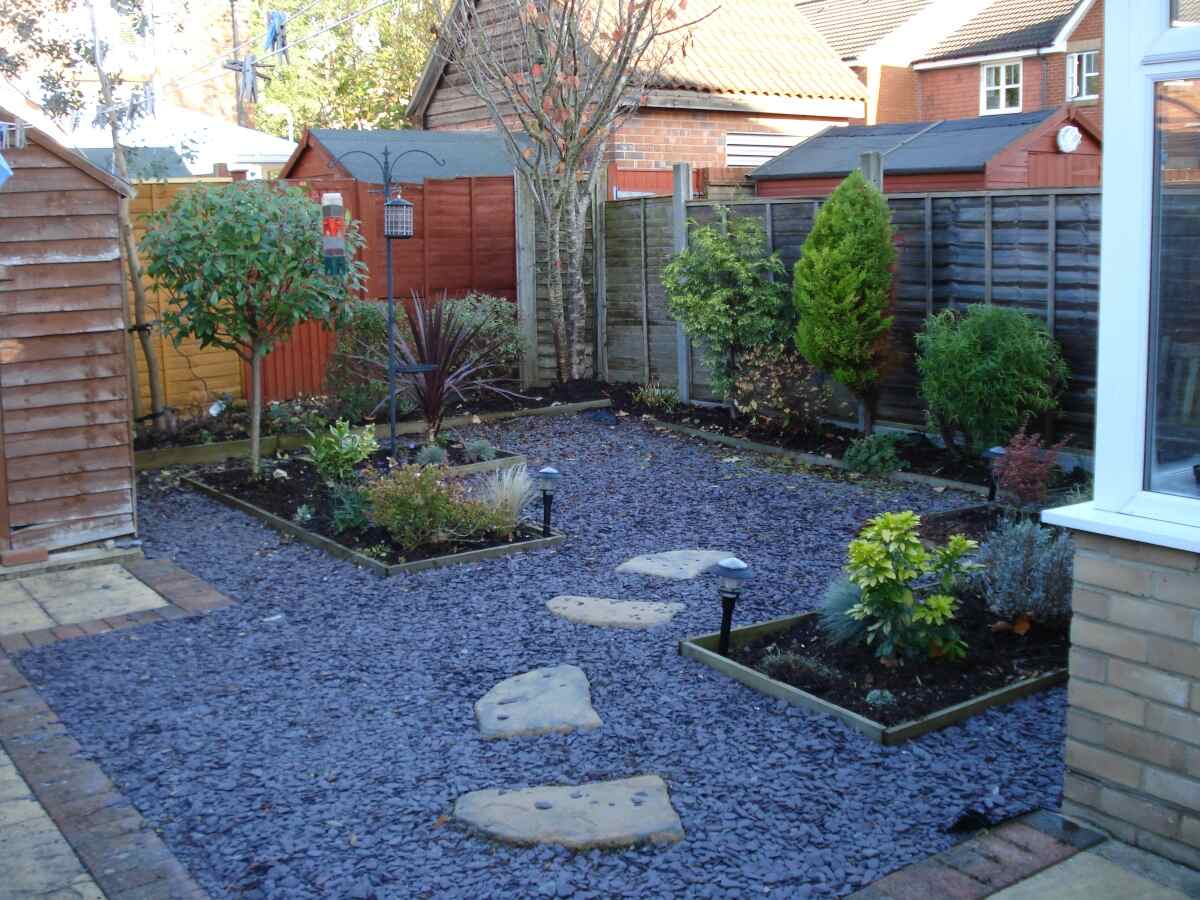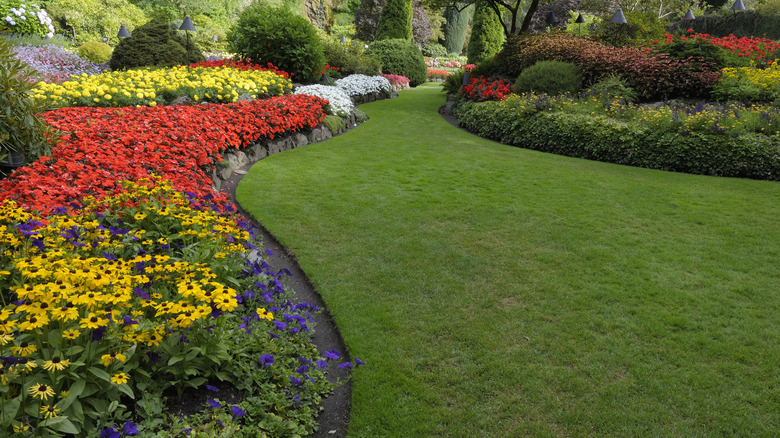Exploring Different Kinds Of Landscape Design to Improve Your Outdoor Atmosphere
Landscaping plays an important role in defining outside rooms. Numerous styles, from conventional gardens to contemporary minimalist styles, offer distinctive benefits for improving looks and feature. Incorporating aspects like xeriscaping and indigenous plants can add to ecological balance. Understanding the interaction of hardscape and softscape is essential for creating welcoming settings. The options offered can be frustrating, triggering one to assess which design finest straightens with their vision for an outdoor sanctuary.
Traditional Yard Landscape Design

While many contemporary yards welcome minimalism and indigenous growings, typical yard landscaping stays a valued technique that highlights balance, framework, and ornamental attributes. This style usually integrates official geometric layouts, where hedges, paths, and flowerbeds are arranged with precision. Central focal points, such as sculptures or water fountains, draw the eye and supply a feeling of harmony.Traditional landscape design frequently consists of a selection of plant kinds, showcasing seasonal blooms and evergreen aspects. Classic shrubs, perennials, and annuals develop dynamic shades and textures throughout the year. In addition, arcs, pergolas, and trellises include vertical interest and function as support for climbing up plants, improving the total aesthetic.The use all-natural products, such as stone and timber, additional enhances the standard landscape, adding to a timeless top quality. Ultimately, this style welcomes relaxation and pleasure, making it a beloved option for those seeking a stunning outside atmosphere.
Modern Minimalist Landscaping
Modern minimal landscaping emphasizes simpleness and capability, defined by open spaces and clean lines. Key features include a limited plant scheme and thoughtful hardscape style that focuses on use and aesthetic appeal. Efficient plant selection techniques further improve the minimal method, producing tranquil outdoor environments that urge relaxation and consideration.
Secret Qualities of Minimalism
A growing pattern in landscaping is the welcome of minimalism, identified by simpleness and functionality. Minimal landscape design concentrates on tidy lines, open spaces, and a minimal color combination, advertising a feeling of serenity. Aspects are carefully curated to prevent mess, permitting each element to stand out. Making use of natural products, such as stone and wood, enhances the natural feeling while keeping an aesthetic balance. Furthermore, minimalist designs usually integrate geometric shapes, which can create aesthetic interest without overwhelming the detects. Water attributes may be included, acting as focal points that boost tranquility. On the whole, minimalism in landscape design highlights the beauty of restraint, enabling nature's integral qualities to beam through in a harmonious outside setting.
Plant Selection Methods
Reliable plant selection is crucial for accomplishing the desired visual in modern-day minimalist landscaping. The emphasis needs to get on simplicity, using a limited scheme of plants that complement each other and the surrounding environment. Indigenous plants are commonly ideal, as they require less maintenance and water, advertising sustainability. Selecting types with varying elevations and structures can include visual interest without frustrating the space. Organizing plants in collections instead than scattering them boosts communication and enhances the minimal motif. Evergreen ranges can supply year-round framework, while seasonal blossoms introduce subtle color changes. Inevitably, the objective is to create a peaceful exterior area that symbolizes tranquility and consistency through thoughtful plant selections.
Hardscape Design Concepts
Important components in hardscape design significantly add to the general aesthetics and capability of minimalist landscaping. This style approach highlights clean lines and underrated products, producing an uncluttered aesthetic experience. Secret parts include pathways, outdoor patios, and maintaining walls, which not just define areas but likewise enhance access and use. The usage of products such as concrete, rock, and timber prevails, showing a natural yet contemporary visual. Incorporating balanced formats and geometric shapes further strengthens the minimal approach, permitting an unified blend with surrounding plant. Additionally, proper drain and disintegration control are vital factors to consider, making sure longevity and sustainability. Ultimately, reliable hardscape design works as a structure that matches softscape elements while preserving equilibrium and simplicity in exterior settings.
Cottage-Style Landscape design
Cottage-style landscape design supplies a delightful strategy to creating inviting outside rooms. By integrating enchanting plant mixes, this style fosters a feeling of warmth and whimsy. The focus on comfortable, well-defined locations motivates relaxation and pleasure of nature.
Charming Plant Combinations
Although lots of house owners seek to develop a picturesque exterior area, accomplishing the charm of cottage-style landscape design often rests on thoughtful plant combinations. Lively blooms, rich foliage, and aromatic natural herbs can be skillfully coupled to evoke a sense of fancifulness and nostalgia. As an example, combining lavender, daisies, and foxgloves develops a vivid tapestry that attracts pollinators while supplying a delightful scent. Incorporating ornamental yards like miscanthus can include structure and motion, enhancing the softer blossoms. Additionally, mixing annual and seasonal plants warranties continual color throughout the periods. The usage of climbers, such as clematis or honeysuckle, can improve upright interest. On the whole, these combinations not just beautify the landscape however additionally cultivate a captivating and inviting atmosphere.

Relaxing Exterior Areas
Creating cozy exterior areas calls for a cautious mix of convenience and appeal, complementing the vibrant plant mixes located in cottage-style landscaping - Landscape Lighting Installer. These areas commonly include inviting seating arrangements, such as weather-beaten wooden benches or supported chairs bordered by rich greenery. Soft illumination, like fairy lights or lanterns, adds warmth, transforming the room into a relaxing hideaway. Incorporating elements such as trellises decorated with climbing roses or great smelling natural herbs improves sensory experiences. Furthermore, pathways constructed from rustic stones welcome expedition and connection with nature. Ornamental touches like birdbaths or whimsical yard art contribute to a feeling of whimsy. Eventually, the goal is to produce a charming environment that motivates leisure and satisfaction of the elegance bordering these comfortable exterior havens
Xeriscaping for Water Conservation
Just how can communities stabilize aesthetic landscaping with the pressing requirement for water preservation? Xeriscaping becomes a practical solution, advertising lasting methods that lessen water use while boosting outside beauty. This landscaping method concentrates on using drought-resistant plants native to the area, which require significantly much less water than typical yards. By integrating compost and effective watering systems, xeriscaping lowers dissipation and drainage, more saving valuable water resources.Communities can develop aesthetically attractive landscapes with mindful planning, picking a diverse range of appearances and shades that prosper in arid problems. Furthermore, home xeriscaping urges making use of ornamental rocks and attractive crushed rock, supplying practical and appealing choices to turf lawns. As communities embrace this environmentally friendly anonymous technique, they not just minimize their water usage yet likewise promote biodiversity and durability in their local ecological communities. Eventually, xeriscaping offers as a demo of the harmony between visual charm and ecological obligation.
Hardscape Style Components
Hardscape style elements play an essential function in boosting outside areas by supplying framework and capability. These non-plant attributes, such as patio areas, decks, walkways, and walls, create aesthetic passion while offering sensible functions. Making use of products like stone, block, and concrete, hardscaping adds to the general visual allure and longevity of a landscape.Incorporating hardscape components can specify areas within a yard, guiding motion and urging social communication. For instance, a well-placed pathway can attach different areas of the yard, while keeping walls can handle elevation modifications and prevent erosion.Furthermore, hardscape layout can boost ease of access and safety, offering stable surface areas for walking or relaxing. Efficient assimilation of hardscape elements enhances soft landscaping, ensuring a balanced outside atmosphere. Ultimately, thoughtful hardscape design enhances not only the charm of outside areas yet also their use, making them more welcoming and useful for site visitors and home owners alike.
Exterior Living Spaces
While outside space supply a seamless blend of convenience and nature, they act as necessary expansions of a home, enhancing way of life and recreation. These locations can include patio areas, decks, or outside kitchen areas, developed to foster relaxation and entertainment. Outdoor Lighting Installer. By incorporating practical furniture and fashionable style, property owners produce welcoming ambiences for celebrations or quiet evenings.The combination of shade frameworks, such as awnings or pergolas, protects against the elements while maintaining an open feeling. Fire pits and outdoor heating systems extend usability into cooler months, offering heat and atmosphere. In addition, incorporating lighting attributes improves the room's functionality after sunset, creating a wonderful night atmosphere.Landscaping components, such as boundaries and pathways, further specify these areas, assisting activity and adding visual allure. Ultimately, outside living rooms transform yards into versatile retreats, advertising a lifestyle that welcomes both nature and convenience
Native Plant Landscaping
Native plant landscaping stresses making use of aboriginal plants to create harmonious and lasting outside environments. This approach not just improves biodiversity yet also preserves water and decreases the requirement for chemical plant foods and pesticides. By picking plants that are indigenous to a certain region, homeowners can assure that their landscapes are well-adapted to regional soil and climate problems, causing lower maintenance requirements.Additionally, indigenous plants supply vital habitats for regional wildlife, including butterflies, bees, and birds, advertising ecological wellness. Landscape designs that incorporate these plants often include naturalistic layouts that simulate local ecological communities, fostering a sense of area and link to the environment.Furthermore, native plant landscaping can add to dirt stability and erosion control, making it an ecologically accountable choice. Overall, this technique not only improves outdoor areas however also supports the neighborhood community, producing a lasting balance between human activity and nature.

Regularly Asked Questions
How Can I Pick the Right Landscape Design Style for My Home?
Selecting the ideal landscaping style for a home entails reviewing the property's style, environment, and personal preferences. Outdoor Lighting Installer. Investigating various styles and seeking advice from experts can supply assistance to create a harmonious outside room customized to specific demands
What Is the Ordinary Cost of Expert Landscape Design Solutions?
The ordinary cost of specialist landscaping services commonly varies from $1,000 to $5,000, depending on task complexity, place, and dimension. Property owners ought to consider obtaining several quotes to guarantee they obtain fair pricing and top quality service.
Exactly how Often Should I Preserve My Designed Yard?
The regularity of keeping a landscaped backyard commonly relies on the features and plants existing. Usually, regular maintenance every couple of weeks is suggested, with seasonal tasks raising in frequency during from this source top expanding seasons for optimal health and wellness and aesthetic appeals.
Are There Landscaping Alternatives for Small Urban Spaces?

Various landscaping choices exist for tiny metropolitan rooms, consisting of upright yards, container plants, and rooftop yards. Incorporating these elements can make best use of restricted locations while supplying plant, enhancing aesthetic appeals, and boosting air quality in urban settings.
What Plant kingdom Are Ideal for Attracting Neighborhood Wildlife?
The very best plants for drawing in neighborhood wild animals include indigenous blooming varieties, berry-producing bushes, and diverse yards. These plants provide essential food and environment, promoting a flourishing environment that sustains different birds, bugs, and tiny creatures. Numerous homeowners look for to create a stunning outdoor space, attaining the appeal of cottage-style landscape design often pivots on thoughtful plant mixes. Developing comfy exterior spaces needs a mindful mix of convenience and beauty, complementing the lively plant mixes discovered in cottage-style landscaping. Native plant landscaping highlights the usage of aboriginal vegetation to develop lasting and unified outside environments. Landscape makes that incorporate these plants usually include naturalistic designs that mimic local ecosystems, promoting a sense of place and link to the environment.Furthermore, native plant landscaping can contribute to soil stability and erosion control, making it an eco liable selection. Different landscape design alternatives exist for little urban rooms, consisting of upright yards, container plants, and roof gardens.